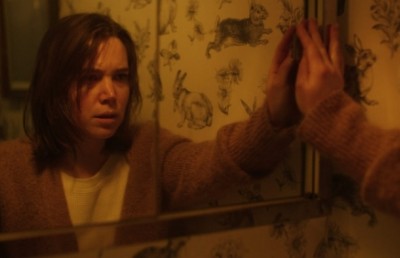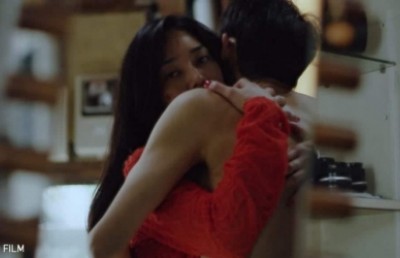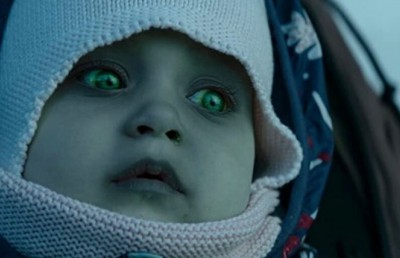Fantasia 2020: The Pandemic Year
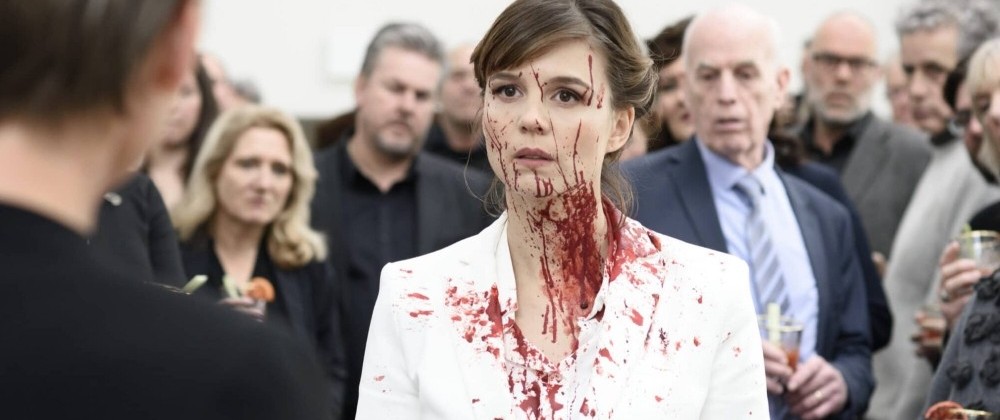
SPOILER WARNING FOR THE FILMS DISCUSSED
Fantasia has always been somewhat of a path-setter, especially when it comes to giving proper respect and coverage to genre cinema. But for 2020 Fantasia had to follow the lead of other festivals and migrate their festival to the world of 0’s and 1’s, the internet. While the community spirit Fantasia is famous for can never be fully replicated online, Fantasia managed to compensate to some extent by increasing, by a huge margin, the space for filmmakers to engage with each other, their fans (through Discord, Live Zoom sessions), programmers and film critics with dozens of online Zoom meetings that were featured, usually after a film screening. What I loved was that these live Zoom sessions were then made available on the Fantasia Youtube page (and are still there as of this writing). This made it less stressful to stay on top of things and it was nice to have the option of revisiting a related panel discussion a few days after seeing the film, or in the case where you view the film at a later time than its initial screening. Currently on the Youtube page trailers for the upcoming 2021 edition are placed at the top, with last year’s panels and interviews listed below. Many of these have ongoing value for the cinephile, critic or genre film academic, like the John Carpenter Masterclass, the Rue Morgue panel on Print Publication, Afrofuturism: Visions of Future from the “Other” Side” presented by Carolyn Mauricette, and one I was featured on entitled “Boutique Video Labels and Festival Communities in Pandemic Times”. So my hope is that this Youtube page remains active and works as an archive for Fantasia from the Pandemic era on.
Of course the online platform made it much easier to get to films (no more travelling, no more lineups!!!!) and to see any film that struck your fancy. For this report I’ve decided to feature a selection from the many films screened, ranging from my favorites to some less successful films.
Dead Birds (2018, Johnny Kenton, written by Amelia Spencer)
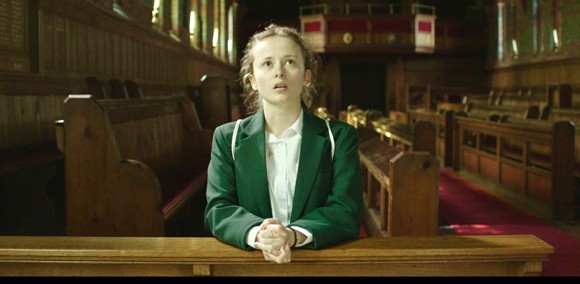
Dead Birds is a stylish teenage girl fantasy wish fulfillment which would have gone over really well with a live audience. It manages to compress many themes, from religious repression, peer pressure, familial pressure, to sexual abuse and sexual identity. A young girl Elsa Evans (Shannon Tarbet) must deal with the pressures of a preppy all-girl’s Catholic school and the hierarchy of the badminton team. Elsa is an average player but must live with the glory of her mother, whose prowess in badminton is feted by a photo prominently displayed in the school’s legacy display window. Even the predatory male coach, who has a creepy habit of casually placing his hand on players, reminisces over her mother’s achievements. Elsa’s mother, Suzy (Tara Fitzgerald), is the kind of mother who is jealous of her own daughter and passive-aggressively takes every opportunity to belittle her. Rather than the supportive mother, she is the monstrous mother. When Elsa begins to improve and gain confidence, her mother knocks her down a few notches by forcing her to put on the high school uniform she wore during her victories, and revels in sadistic glee knowing that Elsa is a few pounds heavy to get into her uniform (you can just hear her say, “my you are not as slim as Mommy was”).
A visit to the chapel to ask for help (after her mother says it would take a miracle for her to get good enough by game day Saturday) leads to the appearance of a ghostly St. Sebastien (arrows and all), played deliciously and forever bathed in white light, by Luke Newberry. The apparition acts like the devil rather than God, and challenges her with three tasks before granting the wish she craves: to win the tournament. In exchange Eva must steal a lock of hair from a classmate, the shoes from another player and make a human sacrifice. Elsa comes close to pushing the one classmate who is nice to her death, but decides otherwise. Her mother intimidates Elsa during the big Saturday match which causes her to play poorly. The referee calls for an intermission after Elsa falls to the ground and is visibly upset. While in the dressing room Suzy visits and gloats over her daughter’s sporting failure. Elsa responds by bludgeoning her mother with her racket (we assume to death). She returns to the gym all bloodied, kisses a girl she is attracted to, then serves the birdie directly into an unsuspecting opponent’s eye!
From this point the film slips fully into fantasy mode as Elsa floats above the gym floor, white light aglow and St. Sebastien egging her on from the balcony. How much of this is in Elsa’s imagination is unclear, nor important, as the film is meant to feed off the audience empathizing with Elsa’s cathartic freedom from her mother’s dominance. The film builds stylistically away from realism by the use of garishly colored shots, slow motion, the appearance of St. Sebastien and the use of Stefano Fasce’s retro score which recalls Disasterpeace’s score for It Follows (which makes it great in my book).
Monster Seafood Wars (Minoru Kawasaki, 2020)
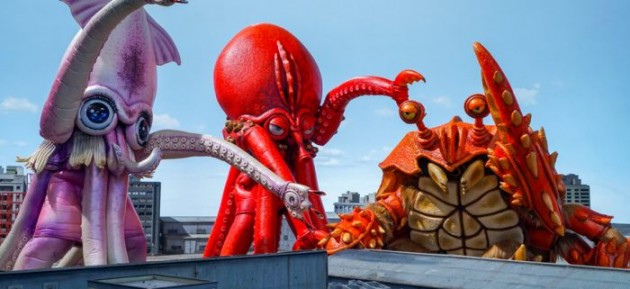
I was super excited for this Japanese Kaiju eiga spoof. Who better than the Japanese to spoof themselves? Well, the end result was somewhat disappointing mainly because the filler non-monster parts are not that interesting and the kaiju eiga moments don’t elevate the film above the filler largely because the costumes and minimal sets never convince you that the monsters can be menacing. The plot echoes Shin Godzilla, with different factions, military, scientists, trying to come up with ways to defeat the three monsters, who are a result of a product invented on the premise of increasing food size to help put an end to famine. When someone drops their meal of mixed seafood into the river —like all Japanese Kaiju eiga films, the terror starts in the water— a huge squid comes out of the water attacking Tokyo. You know you are in for low expectations when the monster effects remind you of those huge blow up balloons next to gas stations by the side of the road. The colored Styrofoam monsters also don’t have much personality, only the crab with its sideways movements, adds some humour. The love triangle between two young (too young to be believable as research scientists) nemesis scientists and the woman they both love, feels out of place in a Kaiju Eiga film, which are notorious for never having love interests (outside of the love interest in Godzilla, which is played down). The love interest doesn’t do much except look pretty and scold the two men. It ends with a Giant Food chef robot defeating the three monsters (who are very tasty) and making them stadium-sized food bowl. The most interesting part of the film is its production history. According to 366 Weird Movie website, [https://366weirdmovies.com/fantasia-film-festival-2020-capsule-monster-seafood-wars-2020/], “Kawasaki based Monster Seafood Wars on an unproduced screenplay by Eiji Tsuburaya about a giant octopus eventually defeated by a vinegar gun. If it had gone into production, that unmade project would have pre-dated Godzilla”. One also senses that if this had been produced by Tsuburaya in the 1950s or 1960s the execution would have been far better. Not so much because of the goofiness of the monsters —if you look at his post-Godzilla 1965 TV show Ultra Q you’ll see some episodes marked by equally goofy monsters— but because they always retain a quality of wonder which makes them more believable. Tsuburaya does not just make his monster the same thing but bigger, but bestows them with character and a hint of surrealist absurdity. Plus the miniature work and cinematography, which is high key and flat in Monster Seafood Wars, is far superior in Tsuburaya’s work, which is why I’ll continue to return to his films and TV shows of the 1950s and 1960s, and not Monster Seafood Wars.
The Columnist (2019, Dutch, Ivo van Aart)
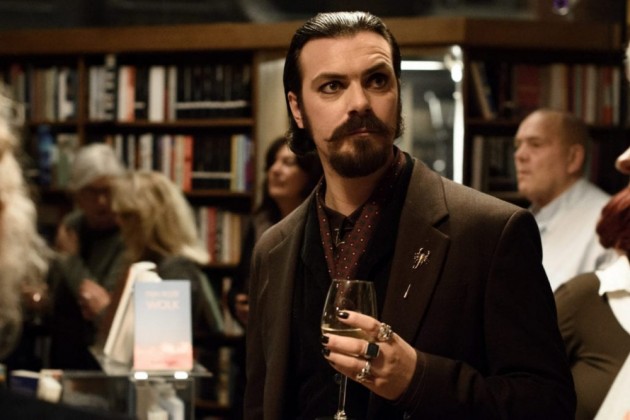
Steven in his ‘goth’ role in The Columnist
The Columnist is reminiscent in part of the darkly humorous female anger film Prevenge, if nowhere near as good, satirical, or funny. A frustrated writer Femke Boot (Hatja Herbers) who earns her living as a columnist writing women themed pieces takes her attacks against social media a bit too seriously and far too personal. Her boss, a careerist 50-something arch capitalist wants her to capitalize on her popularity and write a novel, comparing her to a man, Steven Dood (Bram van der Kelen), who writes successful horror novels and looks the part. Femke encounters Steve on a TV show, where Dood takes the stance of the arch right-winger attacking liberal attitudes against Femke, but when we meet him we learn that this is just an act to help sell books. This is one of the points the film makes, which paints Femke in a negative light for not at least acknowledging this, that everyone, whether a writer, a columnist, or someone on Twitter, is playing a role. Director Aart constructs a thematic irony with all his characters. Dood writes violent stories, and Femke tries to frame her own bursts of violence as a “letting out steam” similar to Dood’s fictional violence. And even claims his art is a reflection of hate, which he clearly never says.
While Femke is a Kantian nemesis of the worse advocate for free speech —hate speech— her teenage daughter Anna Boot (Claire Porro) is just as arch in her defense of free speech, to the ire of her high school principal. But whereas Anna and Steven convert their strong positions into positive outcomes –art and activism— Femke simply spirals into psychopathic murder. Her first kill is the best because we don’t know yet what she is capable of or how far she will take her ‘activism’. As it turns out, her annoying neighbor, who is one of those perennial renovators always making noise, is also one of those anonymous hate tweeters. The scene begins with the neighbor on his slanted roof repairing a shingle. She shares the roof with him and peeks out her attic roof window. She slowly slips onto the roof, sneaks behind him, the man’s radio music masking the sound of her steps, and then casually pushes him off the roof to his death. Femke has quite literally, slipped over the line from angry citizen to sociopath.
Femke turns the nemesis Steven into her lover, and they start a relatively normal relationship. He moves in and they sit next to each other on their laptops writing. A perfect couple. Only when Anna finds a gym bag full of bloody tools in the shed does she put this and the run of murders on the news together and points the finger at Steven, the horror novelist (like the racist cop who automatically assumes the black man is the culprit, Anna assumes the person capable of fictional murder is the guilty one). She also finds the box of victim’s fingers that Femke ritualistically collects (stealing them symbolically of their writing digit) and Anna blames Steven for the deaths. When Femke shoots Steven, we assume Anna will back up her mother. After this scene Femke, dressed in all white, goes to her book launch, playing the part of the monstrous feminine with Steven’s real blood spattered on her face, neck and body matching the similar splashes of red on her white book cover and launch poster. The gathered literati and intellectuals all buy into her ‘look’ as part of her role, no different from the goth look horror writer Steven adopted. Only difference is that with Steven it was an act, but for Femke, a reality.
12 Hour Shift (Brea Grant, 2020) and Yummy (Lars Damoiseaux, 2019)
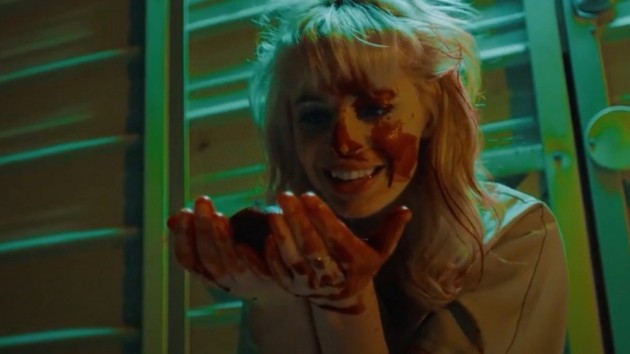
Dimwitted Regina
Two films at Fantasia, Yummy (Lars Damoiseaux, 2019) and 12 Hour Shift (Brea Grant, 2020), remind us that while not all films that take place in a hospital are horror films, the tradition of horror in a hospital setting is a long one (The Cabinet of Dr. Caligari (1920), The Beyond (1981), The Kingdom (1994), Visiting Hours (1982), Halloween 2 (1980), Unsane (2018), The Ward (2010)). In 12 Hour Shift Angela Bettis plays spinely nurse Mandy who must contend with the stupidity of her cousin (by marriage, as she is wont to say) Regina (Chloe Farnworth) to facilitate her illegal black market organ transplant side business. On top of her own drug addiction. It is Arkansas 1999 and the film, which is orchestrated by Matt Glass’ percussive, patchy score, underscores a sense of dreary inevitability. It is a black comedy rather than outright horror film, while Yummy, falls more comfortably in horror (and is darkly comical as well). Both films use the hospital as a setting for a descent into Murphy’s Law gone sickly wrong. In Yummy a young woman who wants a beast reduction is taken by her boyfriend’s mother, a frequent client, to a shady Russian hospital which specializes in plastic surgery with no questions asked. But down below in the bowels of the hospital is an experimental operating room where the surgical misfires have resulted in zombies. Before long there is a spread and hungry zombies feast on the patients, staff and visitors. The gore is good old-school prosthetics and includes some wonderful gore gags, like the one that involves a local actor who has undergone penis enlargement surgery. A young woman excited by his celebrity status initiates a sexual encounter. Against his better judgement, the actor can not resist the chance of having sex with an attractive younger woman. When the friction from intercourse causes too much pain to his fragile penis the woman rubs it with what she thinks is a soothing ointment. It isn’t. The penis catches fire. She uses a fire extinguisher on it, which just freezes the erection, which she then touches, causing the head to shatter in pieces! Guaranteed there is not one man in the audience who did not cringe and cross his legs at this gore gag!
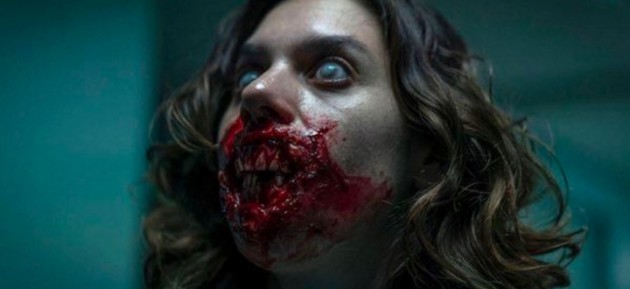
Yummy
In 12 Hours Shift Mandy and her head nurse Karen (Nikea Gamby-Turner) have an illegal side business dealing with organ transplants, by drawing on dead or dying patients and in some cases, euthanizing the sickly. Things are going fine until Mandy hires her dumb blond cousin Regina to be the transport. Things start off bad when she leaves the bag of organs on the floor next to a vending machine, to get some pop which she proudly says will help keep the organs cold. Unfortunately she returns to her buyer with only cold pop, and is threatened that her own kidney will be taken out of her if she does not return in an hour with the agreed upon kidney. Things go from bad to worse with Regina determined to procure them herself when Mandy refuses. The film is shot in a real hospital ward, apparently they had access to a whole floor, and is, crazy violence aside, a disconcerting look at what can transpire in a hospital staffed with overworked and underpaid employees. Strangely, since it is a overnight shift, the focus is on nurses, and we never see a doctor. Nurses and their patients, some remain silent in bed, others becoming minor characters: a woman in a coma; her worried daughter; a dangerous prisoner who attempts suicide (David Arquette), a couple of security guards, a bumbling country pumpkin policeman. Regina knows nothing about killing people, and less about removing an organ, but that doesn’t stop her from trying. Her first kill is a complete waste: when Mandy tells her she uses bleach as part of her arsenal, she misinterprets that to mean she gets them to drink it. So she stuffs bleach down the throat of a 67 year old man on dialysis not knowing what that means for the kidney. When the buyer’s strong arm comes to collect Regina things turn uglier, all the while poor Mandy somehow manages to maintain her cool along with her nurse partner in crime Karen. In the end they manage to escape suspicion, although a hypochondriac who finds the organ bags placed in the cooler suggests the hunt might still be on. In the end even with all the disarray caused to her by Regina’s utter incompetence, Mandy protects her cousin (blood is thicker than water they say). The film concludes with an hilarious scene that hammers home Regina’s incompetence. Mandy tells Regina to go home but to remove her bloodied nurse’s uniform. Regina complies. She removes her shirt down to her bra. When she removes her pants we see she that she has no panties because she used them to store a bladder that she mistook for a kidney. She then walks across the parking lot with her behind proudly showing in broad daylight. Mandy goes into her car and wakes up several hours later ready to return to work for another shift. Yummy.
The Block Island Sound (Kevin and Matthre McManus, 2020)
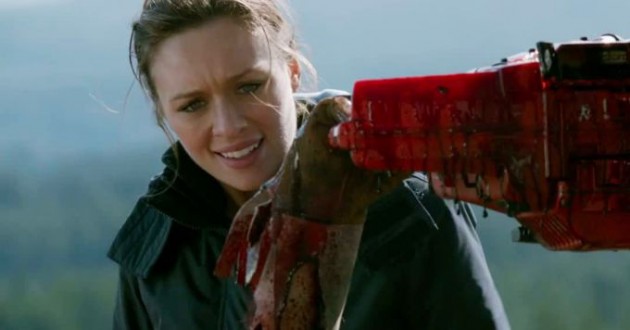
The Block Island Sound
It is a truism that horror breeds on social and psychological fears. And while some horror films treat these in the most obvious and general way –like the fear of an ugly death, disease, random violence- there are some that tap into more pertinent fears that are temporally relevant to the times. Take the environment. Although the knowledge of how much humans have messed up the earth and the urgency of the situation is a current hot topic, the environment has always been a theme horror has tapped into. The impact of nuclear arms race on the 1950s is an obvious example. But there have been many recent horror films that are seriously concerned with the environment and use this global fear as a narrative template. One of the most interesting and thematically complex of these seriously committed environmental horror films is The Block Island Sound (2020, The McManus brothers), which takes the real life idea of people who suffer from environmental sensitivity and turns it into a genuine horror atmosphere. The setting is a small island fishing community, where strange electromagnetic charges are causing tons of dead fish to sweep ashore, birds to drop dead from the sky and electronic devices to malfunction. But humans are not unaffected. In this story it happens to be people who have come in close vicinity of the zone where the unnatural activity occurs, in the waters off the island. The story recalls another film I saw recently Island Zero (John Gerritson, 2018), which is also set on a small island fishing community in Maine, but even such trash classics as Birdemic and Birdemic 2, as terrible as the narrative design is, have strong environmental concerns. Others like The Bay (2012), The Last Winter (2006), The Beach House (2020). Even the recent Richard Stanley H.P. Lovecraft adaptation The Color Out of Space can be read through environmentalism.
Block Island Sound is punctuated by a great script. I love the way the biology researcher mother Audry’s (Michela McManus) explanation for why she takes fish out of the water to study and put back into the ocean, returns at the end as the final voice-over but becomes aligned to the bizarre, alien activity as explained by the former native who was inflicted with the curse/disease and saved himself by living off the grid, now takes on a wholly different meaning, a stringent critique on government and industry exploitation of nature. (Evil corporate profit is the cause of the environmental horror in Island Zero as well.). In the film the force pulls all things under its geographical vicinity up into the sky, like a huge magnet, only to let them fall back down. The ‘infected’ recluse living in the trailer scares the sister with his hysteria, but his claim is that aliens are borrowing humans to study us, get to know us, exactly as humans to do the fish. Like most horror, family is at the centre. The brother lives with his father, who may be at the onset of dementia, given his odd black outs, memory losses, sleep walks and moments of disconnection. The mother is recently passed. Two sisters have left the island and have a fulfilling career, one nearby the other in NYC. But what seems like a story about a fractured family dealing with an aging parent, grief and possibly mental illness, turns into a horror story on how environmental illness can turn a person into a murderer.
The Block Island Sound Fantasia Panel Talk: https://www.youtube.com/watch?v=zTIvsJByK_Y
Fantasia always remembers its roots, and the early years which were heavily laced with retro titles that the programmers often programmed because they wanted to revisit their favorite films on a big screen. Which is why there were many Asian martial arts and Kaiju films and horror films from the 1970s and 1980s in the first few years of Fantasia. One such film in the 2020 edition was the 1996 urban noir No Way Home , directed by Fantasia regular and fan favorite Buddy Giovinazzo. The festival screened a lovely digital restoration of this gritty gangster-noir thriller which is a great blend of Buddy Giovinazzo’s melancholic tone with Scorsese street realism. You could see touches of Mean Streets (1972) and Combat Shock (1986). In fact, No Way Home and Combat Shock are both ‘apartment’ films. What separates Buddy from Marty is that Buddy’s heart is much more with the working class underdog than Scorsese, who is more driven by cinematic gangster antecedents than Giovinazzo. The difference can be reduced to (Buddy) Staten Island vs (Marty) Manhattan. Tim Roth plays Joey, just released from prison to rejoin with his older brother Tommy (James Russo), now married to a street smart woman, Lorraine (Deborah Unger).
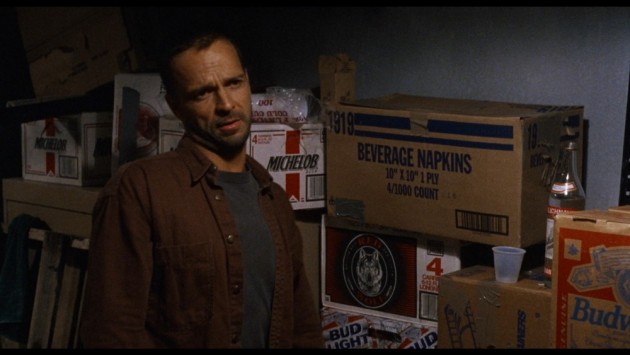
No Way Home
The story is set in Staten Island, the same downtrodden location as Combat Shock, and the streets and economy of the city is impoverished, a 1996 that looks like 1970s. Joey survived in prison and has the scars to prove it. His beatings and harsh life in prison is shown to us in brief flashbacks that intercut with Joey being administrated out of prison. This crosscutting sets up an editing style that comes back later in some key moments which somehow symbolically encapsulate the two brothers. In the first scene Tommy sleeps with a stripper in the back of a strip joint while Joey is railroaded into fighting the burly door man in the bar’s back alley. Sex and violence are intermixed. In the other crosscut, the film cuts between Lorraine on a strip-o-gram job at a middle-aged man’s birthday party and Tommy being railroaded by the drug lords who he owes money to. Phoney sex and real violence. We learn that Joey’s time in prison was a fall for his brother Tommy. In another flashback we learn that it was Tommy who killed the TV store employee and Joey took the blame for it. And to show how people are set in their ways, Tommy kills Joey’s parole officer later in the same way: a blow to the head as they walk into a room. In both cases, the act was premature and rash. But the difference is that in the second case, Joey does not take the fall. The film has a tenseness to it in the way that every scene feels like violence bubbling under the surface, about to explode. This climaxes at the end when the police surround their home after the bloodbath, and Joey and Lorraine both exit the house with their hands up. Tommy is still inside thinking his plan. In the viewer’s minds, knowing how self-destructive Tommy is, we think he is going to shoot Joey in the back; instead he goes onto the front porch and places himself into a “no way out” scenario, threatening the police and in effect forcing them to shoot him. Lorraine is taken away to the hospital and is never seen again. Joey boards a bus and looks at the ‘mean streets’ of his past while driving away from Staten Island. A happy ending as far as a Buddy Giovinazzo the film goes. Happy for Lorraine, who is free of the well meaning but destructive Tommy, and Joey free of his past.
It is nice to see James Russo’s performance, clearly modelled on James Caan’s head hot Sonny from The Godfather, with his stiff body movements and slanted shoulders. Roth plays the slow witted Joey (due to a head injury) with a calm, internal peace which belies his past and supposed violent nature. In 2007 Buddy Giovinazzo married a German woman named Gesine Giovinazzo-Todt and since then has been living and working in Germany. As an interesting aside, both No Way Home and Combat Shock were shot by women, Claudia Raschke and Stella Varveris.
Some Shorts
As always Fantasia places a healthy spotlight on short films. Modern Whore (2020, Nicole Bazuin) stars actress and former escort service Andrea Werhun who gives an insider’s post #metoo expose about the Escort Review Board culture, and how men use it to continue their patriarchal dominance and to pat their wounded egos. We learn that regardless of the me#too movement, men who use this service are never able to imagine the soiree from the perspective of the sex worker. The film is highly stylized, with a retro garish pastel colors look and lots of first-person camera address.
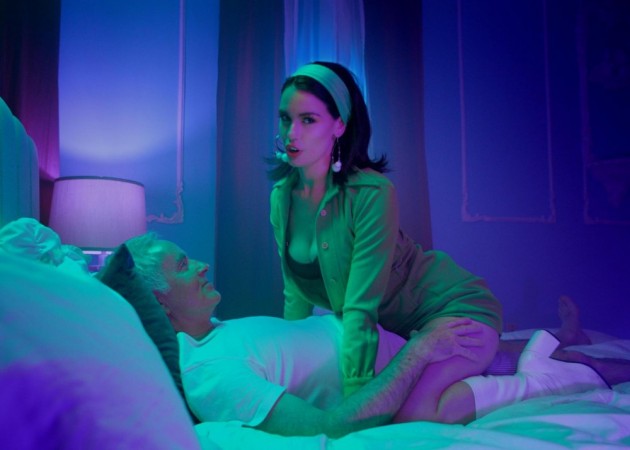
Modern Whore
Abracitos (Tony Morales, 2020) is a reminder of Mario Bava’s statement about only needing a woman, a camera, a room and some lights to make a horror film. This short is nothing but 10 minutes of a maid holding a frightened young girl in her arms, fearing the presence of a ghost or spirt in the room. It is dark, music is tense, and the two characters are terrified. Offscreen space is boiling over with tension. This feels like a short film version of Babadook or Under the Shadows. The short is one long set up to a great jump scare: from a close up of Laura holding the girl tightly to a demon-eyed creature holding the girl and moving back super quickly. The film ends with the girl under the bed: she calls out for “Laura” and we hear the bed mattress squeak.
Ferine (2020, Andrea Corsini, Italy). A mother’s love knows no bounds, can be the subtitle of this odd silent little horror film, which takes us in one direction then shifts to another. The camera opens in the woods. Shot of trees, a rock enters frame and hits something below frame. A human? No a rabbit. A feral woman moves out into the woods into a nearby home, showers, boards a car and drives to an open gas station, where she hunts down a man. She lures him for sex in the car then knocks him out with a brick. The viewer is set up to think of this as a possible rape revenge tale. But then the twist arrives and we see that, like an animal feeding its young, she drags the man to where her children are, bites into the neck to start the feed, and then her son and daughter join in the feast.
As a Monster Generation kid I know first-hand the context of the short film My Darling Pet Monkey (2020, USA, Jim McDonough), having ordered things off the back pages of Famous Monsters of Filmland myself. My Darling Pet Monkey is a whimisical dramatization of an event in 1969 where two boys order a live monkey from the back ad in a Famous Monsters of Filmland magazine, the magazine that was born in 1958 and fed the first generation of kids who grew up watching classical horror films, listening to horror movie hosts and buying horror magazines. Set in a bridge club, 1960s suburban setting, the short is told in first-person VO by one of boys, though it is fictional. Unfortunately, the use of cut-out animation doesn’t add to the ‘monster kid’ vibe –I think old school color animation or stop-motion would have been more appropriate— and it loses cred when the magazine that is shown and clearly meant to invoke Famous Monsters, is called “Monster” magazine. I can only assume the filmmakers were afraid of legal recrimination, but Famous Monsters has appeared as a prop in more low budget horror films than I can remember. It all ends with the monkey escaping, dying, being buried and exhumed by a neighborhood dog.
Peter the Penguin (UK, Andrew Rutter) demonstrates how the right use of style can turn anything into a horror atmosphere. Normalcy can be turned on its head with portentous sound and music, and a disconnect between appearance and reality. A man and woman are seated in a car outside of suburban home. The man is anxious to meet his girlfriend’s young daughter and is desperate to make a good impression. When they enter the home, they find that the daughter is traumatized over the sickly condition of her oversized stuffed penguin. Peter tries to appease her by presenting her with a stuffed lion but the mother and daughter yell in unison, “It’s not big enough”! A normal situation turns, for Peter that is, surreal when paramedics are called in and they too react as if the penguin were a person. Of course this does have a correlative for any parent who knows how attached children can become to their stuffed toys. At a young age any child is fearful that his or her parents may one day strip the room of the stuffed pets. Perhaps this is a child’s first encounter with trauma. The film plays the daughter’s attachment to the penguin as real, which would be fine. Only the parents and paramedics reacting as the girl is NOT in keeping with reality. In the end, Peter is overwhelmed by the behaviour of the adults and leaves, but the paramedics chase after him. They return in the final scene with a new, and “bigger” pet for the daughter: a beat-up looking Peter strapped to a wheelchair with a bloody penguin head over his head. The last shot we see is of Peter, presumably dead, in the garage. Suburban reality made strange.

Gon, The Little Fox
Gon, the Little Fox (2020, Japan, Takeshi Yashihiro) is a beautifully told parable filmed in gorgeously rendered puppet animation that is one of the best representatives of irony I can think of. Irony is one of those modes that is hard to explain but this film plays it perfectly. Set on a farm in rural Japan, we see a father teaching his son the need to kill a fox that is jeopardizing their livelihood by hunting local prey. The son feels bad for the fox and purposely misses his shot. The mother is sick and dying. The father wants to treat the dying mother to a special eel meal and the son catches an eel, but the fox steals it from his satchel and runs off with it, only to wastefully toss the eel back into the lake once it dies. Meanwhile the mother dies, and the other forest animals blame the poor fox for the mother’s death, insinuating that because the fox did not eat eel she died. The fox shows great remorse and begins to bring the poor family food and tokens for the mother’s grave. When the son catches the fox running out of their house he shoots it dead, before he realizes that it was the fox, and not a deity, as the father believed, that was bringing the items to the family. The ironic parable demonstrates how animals can show more compassion than humans; how at times in life compassion is misplaced (the son had it in the opening, when the fox was really stealing from his family; and not when the fox was redeeming itself through generosity).
Also set in a single location, an apartment in Manhattan, is the oddly emotional science-fiction short about love and empathy in a sterile future, The Nurturing (2020, Estaban Pedraza). In a Rear Window setting, a woman named Rebecca (Lauren E. Banks) grieving because her father died alone, dedicates her life to a bizarre ritual of continually spying on her neighbor in the flat across from her. Rebecca straps herself to a Nintendo-style control box that allows her to follow the man’s everyday life in an attempt to raise her empathy level to 100%. The goal being to reach a point where they will be emotionally connected and the world so united that no one will ever have to die alone. Ironically, her desire to unite the world causes her to cast aside her boyfriend, who eats alone, is starved of any physical contact and becomes subservient to his girlfriend’s voyeur therapy. The frustrated boyfriend breaks her control box, but she is unfazed and places it under a flannel cloth, which magically repairs it and reveals a second box. The old adage, if you can’t beat them join them, plays out. Across the courtyard, the man being spied on finds love when a far hipper French man comes over and attempts to renew the man’s taste in style. (Which produces one of the best lines of Fantasia 2020, “They iron corduroy where you are from!”). It ends with Rebecca and her boyfriend tapped into this stranger’s reality, increasing the empathy meter, and playing footsie with each other. This just may be the closest the boyfriend will get to sex in this new age virtual reality.
I will conclude on a very strange occurrence where I watched three films in a row that were so thematically similar —people in a home waiting for someone ill to die, and shit happens— though aesthetically worlds apart, and from different cultures: Kriya (2020, Sidharth Srinivasan, India/UK0), The Dark and the Wicked (2020, Byran Bertino), and Sanzaru (2020, Xia Magnus, UK/Filipino, 2020). Blame it on quarantine.



